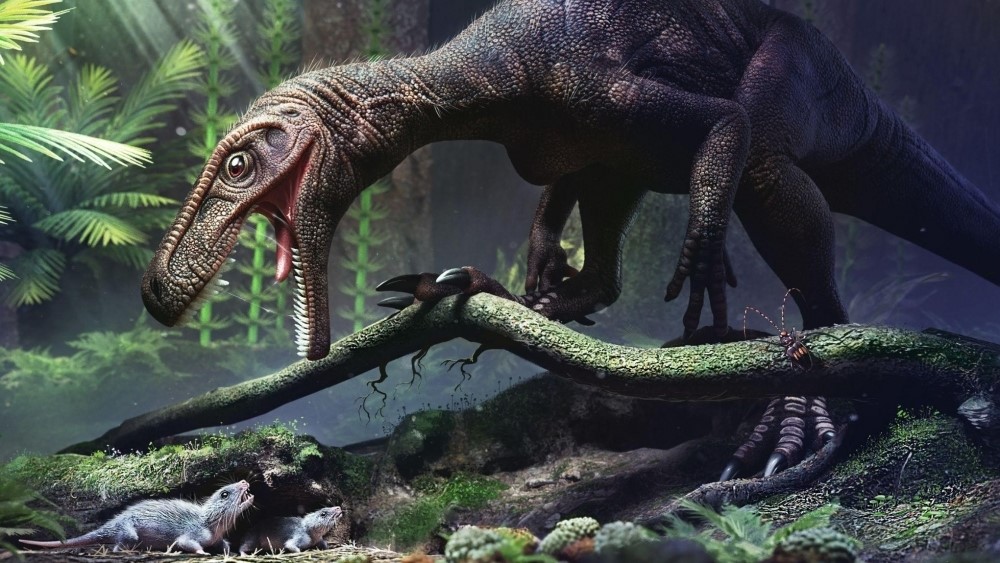Hollow bones in giant dinosaurs and pterosaurs show convergent evolution in action, fossil study suggests
Some of the oldest dinosaurs didn't have hollow bones, suggesting that skeletal air sacs evolved independently in three lineages: long-necked sauropodomorphs, meat-eating theropods and pterosaurs.

Air sacs sandwiched inside the bones of the largest dinosaurs and pterosaurs to roam the Earth were so advantageous that these pockets might have evolved independently at least three times in different lineages, a new study finds.
Researchers already knew that these ancient giants had air bubbles in their bones. Now, evidence that some of the earliest dinosaurs on record lacked these air sacs suggests that they sprouted later, through convergent evolution, a phenomenon in which different organisms independently evolve similar traits.
Pterosaurs, meat-eating theropods and long-necked sauropods belong to a group of ancient reptiles called the avemetatarsalians, which are more closely related to present-day birds than to crocodiles. These three lineages evolved air-filled pockets in their bones, which kept their skeletons light and nimble. Without these structures, the beasts couldn't have grown so large or kept cool in the warm climate of the Triassic period (252 million to 201 million years ago).
"Less dense bones containing more air gave the dinosaurs and pterosaurs more oxygen circulating in their blood, as well as more agility to hunt, flee and fight, or even to fly," study first author Tito Aureliano, a researcher at the Institute of Geosciences at the University of Campinas in Brazil, said in a statement. "They not only used less energy but also kept their bodies cool more efficiently."
Related: Ginormous Jurassic fossil in Portugal may be the biggest dinosaur ever found in Europe
Now, fresh evidence suggests that some of the oldest avemetatarsalians didn't have air sacs, which means that their relatives may have evolved hollow bones independently of one another.
In the study, published Dec. 9, 2022, in the journal Scientific Reports, researchers analyzed 233 million-year-old fossils from three early dinosaur species — the sauropodomorphs Buriolestes schultzi and Pampadromaeus barberenai and the meat-eater Gnathovorax cabreirai — that are among the "oldest good material" from sauropod dinosaurs and meat-eating herrerasaurid dinosaurs, Paul Barrett, a paleobiologist at the Natural History Museum in London who peer-reviewed the study, told Live Science.
Sign up for the Live Science daily newsletter now
Get the world’s most fascinating discoveries delivered straight to your inbox.
"It shows that these complicated air sacs systems, in at least one branch of dinosaurs, only started to become really invasive [permeate the bones] much later in their evolutionary history than in the other two groups of reptiles that developed those systems," Barrett said.
The researchers made detailed micro-CT scans of the bones — unearthed between 2011 and 2019 in Rio Grande do Sul, Brazil's southernmost state — and detected small spaces in the vertebrae that could have housed blood vessels and marrow, but not air sacs.
The new study may help determine whether air sacs in sauropods, theropods and pterosaurs have the same evolutionary origin from a common ancestor, or whether they all achieved it independently through convergent evolution.
"What this study is suggesting is that those three groups may have achieved air sacs independently, because when we look at the earliest members of at least one of those groups, there's no good evidence for the air sacs," Barrett said.
A 2021 study suggested that ornithischians — a group of bird-hipped dinosaurs that lived in the Jurassic and Cretaceous periods (201 million to 66 million years ago) and breathed like weirdos — also lacked air sacs, despite sharing an ancestor with dinosaurs that developed air sacs.
But the story of how air sacs evolved is riddled with uncertainties, according to Barrett. "Not all air sacs are in bones — some of those air sacs we know from living animals actually go between muscles and around organs," he said. "It might be that they all share air sacs and the air sacs are in their common ancestor, but they didn't leave any traces on the bone."
The fact that the researchers didn't find traces of air sacs in the oldest avemetatarsalians "still doesn't rule out that they might have had one that the fossils simply aren't telling us about," Barrett said. It may be that these ancient reptiles had air bubbles in their soft tissue that later penetrated the skeleton, an adaptation which lives on in birds today.

Sascha is a U.K.-based staff writer at Live Science. She holds a bachelor’s degree in biology from the University of Southampton in England and a master’s degree in science communication from Imperial College London. Her work has appeared in The Guardian and the health website Zoe. Besides writing, she enjoys playing tennis, bread-making and browsing second-hand shops for hidden gems.









